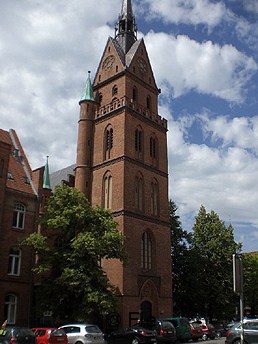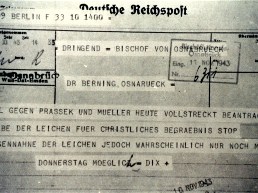History compact
A brief overview of the occurrences
1934
- 1 June 1934: Karl Friedrich Stellbrink begins his ministry as a pastor of the Luther Church in Lübeck.
1939
- 25 March 1939: Johannes Prassek becomes Chaplain (vicar) at Herz Jesu Church, later on First Chaplain.
- 1 June 1939: Hermann Lange becomes a chaplain (adjunct) at Herz Jesu Church in Lübeck, one year later he becomes a vicar.
1940
- 27 August 1940: Eduard Müller becomes chaplain (adjunct) at Herz Jesu Church.
1941
- Summer of 1941: The three chaplains and Pastor Stellbrink get to know each other and realise their common dispositions. They exchange transscripts of sermons preached by the bishop of Münster, Clemens August Graf von Galen, and information broadcast by foreign radio stations. An amicable relationship begins. At the same time, the Secret State Police planted a spy into the Catholic rectory.
- 12 June 1941: Pastor Karl Friedrich Stellbrink takes part of Holy Mass in Herz Jesu Church on the Feast of Corpus Christi and shows exaltation.
1942
- 9 March 1942: Pastor Stellbrink sees a crucifix covered up with a greatcoat at the chapel of the Vorwerk Cemetery after the funeral of a Lübeck Nazi personality. He is shocked that Christ should be denied in this way.
- 29 March 1942: Pastor Stellbrink preaches in the Luther Church on the day after the bombing of Lübeck which destroyed large areas of the city: "God has spoken in a loud voice. The people of Lübeck will once again learn to pray"
- 3 April 1942: Stellbrink is removed from his ministry, the Church Board starts disciplinary action.
- 7 April 1942: Pastor Stellbrink is taken into "protective custody" and is brought to the Lauerhof prison.
- 15 May 1942: Chaplain Prassek is awarded the Air-Raid-Defence Medal of Honour because of his saving patients from the Marien Hospital during the bombing.
- 28 May 1942: The Secret State Police (Gestapo) searches the rectory of Herz Jesu Parish. Johannes Prassek is arrested and transferred to the Marstall Prison in the Burgkloster.
- 15 June 1942: Vicar Lange is arrested and transferred to Lauerhof Prison.
- 22 June 1942: Adjunct Müller is arrested and transferred to Marstall Prison in the Burgkloster Prison.
- 31 Juli 1942: Also arrested are 18 lay people who took part in the group meetings led by the chaplains, among them the parish employees Adolf Ehrtmann and Robert Köster.
1943
- March 1943: Bishop Berning of Osnabrück enquires at the Generalvikariat about the state of the prosecution proceedings for the distribution of sermons by the Bishop of Münster Graf von Galen, in order to achieve an easing of the burden of the Chaplains through precedents.
- 2 April 1943: Defence Counsel Dr. Rudolf Dix writes to Bishop Berning stating it to be of little consequence if any precedents existed, besides, other parts of the indictment were serious enough anyway.
- 5 April 1943: The indictments reach the defence team; there is no mention of the von Galen sermons at all. It appears that Hitler himself ordered the scratching of those passages. Left is a text of illogical and clumsy syntax.
- 17 April 1943: The prisoners are transferred temporarily to remand prison Holstenglacis in Hamburg.
- 18 Juni 1943: At the beginning of their trial the prisoners are transferred back to Lübeck.
- 22 to 24 June 1943: Combined trial of chaplains and lay people at the Volksgerichtshof (People's Court) in Lübeck.
- 23 June 1943: The senate of the Volksgerichtshof in Lübeck sentences the four Lübeck clergymen to death. The verdict criticised Stellbrink as "a Lutheran clergyman who was not afraid to ally himself with a representative of the Catholic Church which fights against Protestantism" and acknowledges the ecumenical dimension of the events in an indirect way.
- 24 June 1943: Adolf Ehrtmann is sentenced to a five years imprisonment, Robert Köster to one year. The other lay people are sentenced to minor imprisonments, which are deemed served by their time in remand.
- 27 June 1943: Petition for Clemency by bishop Berning for the Catholic chaplains.
- 9 July 1943: The Lutheran pastors of Lübeck lodge an appeal for clemency with the Reichsjustizminister (Attorney General) by describing Stellbrink as mentally deranged. The appeal is not supported by the Lübeck Consistory.
- 14 August 1943: The Berlin Consistory lodges a Petition for Clemency for Stellbrink.
- 10 November 1943: In Hamburg prison Holstenglacis Eduard Müller, Johannes Prassek, Hermann Lange and Karl Friedrich Stellbrink are executed at intervals of three minutes by guillotinening. The newspapers do not publish one single line about this.
- 15 November 1943: The bodies of Hermann Lange and Karl Friedrich Stellbrink are cremated in Ohlsdorf crematorium, their ashes are interred later on in Herz Jesu Church and Luther Church. The bodies of Johannes Prassek and Eduard Müller are cremated at the crematorium of Neuengamme Concentration Camp. Their ashes are scattered in the camp's market garden.
1993
- 24 June 1993: The Nordelbian Lutheran Church publishes a statement to rehabilitate and acknowledge the martyr Karl Friedrich Stellbrink.
- 5 November 1993: The 17th criminal division of the District Court of Berlin invalidates the death sentence against Pastor Karl Friedrich Stellbrink.
- 24 June 1993: The Nordelbian Lutheran Church publishes a statement to rehabilitate and acknowledge the martyr Karl Friedrich Stellbrink.












